Effect of Silver Dopants on the ZnO Thin Films Prepared by a Radio Frequency Magnetron Co-Sputtering System
Abstract
:1. Introduction
2. Experimental Procedure
3. Results and Discussion
4. Conclusions
Acknowledgments
Author Contributions
Conflicts of Interest
References
- Steglich, M.; Bingel, A.; Jia, G.; Falk, F. Atomic layer deposited ZnO: Al for nanostructured silicon heterojunction solar cells. Sol. Energy Mater. Sol. Cells 2012, 103, 62–68. [Google Scholar] [CrossRef]
- Lu, T.C.; Lai, Y.Y.; Lan, Y.P.; Huang, S.W.; Chen, J.R.; Wu, Y.C.; Hsieh, W.F.; Deng, H. Room temperature polariton lasing vs. photon lasing in a ZnO-based hybrid microcavity. Opt. Express 2012, 20, 5530–5537. [Google Scholar] [CrossRef] [PubMed]
- Wang, L.; Kang, Y.; Liu, X.; Zhang, S.; Huang, W.; Wang, S. ZnO nanorod gas sensor for ethanol detection. Sens. Actuator B Chem. 2012, 162, 237–243. [Google Scholar] [CrossRef]
- Ho, C.C.; Lai, L.W.; Lee, C.T.; Yang, K.C.; Lai, B.T.; Liu, D.S. Transparent cosputtered ITO-ZnO electrode ohmic contact to n-type ZnO for ZnO/GaN heterojunction light-emitting diode. J. Phys. D Appl. Phys. 2013, 46, 315102. [Google Scholar] [CrossRef]
- Ibupoto, Z.H.; Khun, K.; Eriksson, M.; AlSalhi, M.; Atif, M.; Ansari, A.; Willander, M. Hydrothermal growth of vertically aligned ZnO nanorods using a biocomposite seed layer of ZnO nanoparticles. Materials 2015, 6, 3584–3597. [Google Scholar] [CrossRef]
- Jaramllo-Paez, C.; Navio, J.A.; Hidalgo, M.C.; Macias, M. High UV-photocatalytic activity of ZnO and Ag/ZnO synthesized by a facile method. Catal. Today 2017, 284, 121–128. [Google Scholar] [CrossRef]
- Zhang, X.J.; Chen, Y.; Zhang, S.; Qiu, C.Y. High photocatalytic perfromance of hig concentration Al-doped ZnO nanoparticles. Sep. Purif. Technol. 2017, 172, 236–241. [Google Scholar] [CrossRef]
- Bhatic, S.; Verma, N.; Bedi, R.K. Sn-doped ZnO nanopetal networks for efficient photocatalytic degradation of dye and gas sensing applications. Appl. Surf. Sci. 2017, 407, 495–502. [Google Scholar]
- Saaedi, A.; Yousefi, R.; Jamali-Sheini, F.; Cheraghizade, M.; Zak, A.K.; Huang, N.M. Optical and electrical properties of p-type Li-doped ZnO nanowires. Superlattices Microstruct. 2013, 61, 91–96. [Google Scholar] [CrossRef]
- Ma, Y.; Gao, Q.; Wu, G.G.; Li, W.C.; Gao, F.B.; Yin, J.Z.; Zhang, B.L.; Du, G.T. Growth and conduction mechanism of As-doped p-type ZnO thin films deposited by MOCVD. Mater. Res. Bull. 2013, 48, 1239–1243. [Google Scholar] [CrossRef]
- Ren, X.L.; Zhang, X.H.; Liu, N.S.; Wen, L.; Ding, L.W.; Ma, Z.W.; Su, J.; Li, L.Y.; Han, J.B.; Gao, Y.H. White light-emitting diode from Sb-doped p-ZnO nanowire arrays/n-GaN film. Adv. Funct. Mater. 2015, 25, 2182–2188. [Google Scholar] [CrossRef]
- Yan, Y.; Al-Jassim, M.M.; Wei, S. Doping of ZnO by group-IB elements. Appl. Phys. Lett. 2006, 89, 181912. [Google Scholar] [CrossRef]
- Suja, M.; Bashar, S.B.; Morshed, M.M.; Liu, J.L. Realization of Cu-doped p-type ZnO thin films by molecular beam epitaxy. ACS Appl. Mater. Interfaces 2015, 7, 8894–8899. [Google Scholar] [CrossRef] [PubMed]
- Myers, M.A.; Khranovskyy, V.; Jian, J.; Lee, J.H.; Wang, H.; Wang, H. Photoluminescence study of p-type vs. n-type Ag-doped ZnO films. J. Appl. Phys. 2015, 118, 065702. [Google Scholar] [CrossRef]
- Liu, W.Z.; Xu, H.Y.; Wang, C.L.; Zhang, L.X.; Zhang, C.; Sun, S.Y.; Ma, J.G.; Zhang, X.T.; Wang, J.N.; Liu, Y.C. Enhanced ultraviolet emission and improved spatial distribution uniformity of ZnO nanorod array light-emitting diodes via Ag nanoparticles decoration. Nanoscale 2013, 5, 8634–8639. [Google Scholar] [CrossRef] [PubMed]
- Echresh, A.; Chey, C.O.; Shoushtari, M.Z.; Nur, O.; Willander, M. Tuning the emission of ZnO nanorods based light emitting diodes using Ag doping. J. Appl. Phys. 2014, 116, 193104. [Google Scholar] [CrossRef]
- Zhang, K.; Wang, H.; Gan, Z.K.; Zhou, P.Q.; Mei, C.L.; Huang, X.; Xia, Y.X. Localized surface plasmon resonances dominated giant lateral photovoltaic effect observed in ZnO/Ag/Si nanostructure. Sci. Rep. 2016, 6, 22906. [Google Scholar] [CrossRef] [PubMed]
- Khan, R.; Yun, J.H.; Bae, K.B.; Lee, I.H. Enhanced photoluminescence of ZnO nanorods via coupling with localized surface plasmon of Au nanoparticles. J. Alloys Compd. 2016, 682, 643–646. [Google Scholar] [CrossRef]
- Tarwal, N.L.; Patil, P.S. Enhanced photoelectrochemical performance of Ag-ZnO thin films synthesized by spray pyrolysis technique. Electrochim. Acta 2011, 56, 6510–6516. [Google Scholar] [CrossRef]
- Balachandran, S.; Selvam, K.; Babu, B.; Swaminathan, M. The simple hydrothermal synthesis of Ag-ZnO-SnO2 nanochain and its multiple applications. Dalton Trans. 2013, 42, 16365–16374. [Google Scholar] [CrossRef] [PubMed]
- Cao, L.; Zhu, L.; Ye, Z. Enhancement of p-type conduction in Ag-doped ZnO thin films via Mg alloying: The role of oxygen vacancy. J. Phys. Chem. Solids 2013, 74, 668–672. [Google Scholar] [CrossRef]
- Duan, L.; Yu, X.C.; Ni, L.; Wang, Z. ZnO: Ag film growth on Si substrate with ZnO buffer layer by rf sputtering. Appl. Surf. Sci. 2011, 257, 3463–3467. [Google Scholar] [CrossRef]
- Sytchkova, A.; Grilli, M.L.; Rinaldi, A.; Vedraine, S.; Torchio, P.; Piegari, A.; Flory, F. Radio frequency sputtered Al:ZnO-Ag transparent conductor: A plasmonic nanostructure with enhanced optical and electrical properties. J. Appl. Phys. 2013, 114, 094509. [Google Scholar] [CrossRef]
- Liu, D.S.; Wu, C.C.; Lee, C.T. A transparent and conductive oxide film prepared by RF magnetron co-sputtering system at room temperature. Jpn. J. Appl. Phys. 2005, 44, 5119–5121. [Google Scholar] [CrossRef]
- Liu, D.S.; Sheu, C.S.; Lee, C.T. Aluminum-nitride codoped zinc oxide films prepared by radio-frequency magnetron cosputtering system. J. Appl. Phys. 2007, 102, 033516. [Google Scholar] [CrossRef]
- Liu, D.S.; Tsai, F.C.; Lee, C.T.; Sheu, C.W. Properties of zinc oxide films cosputtered with various aluminum content at room temperature. Jpn. J. Appl. Phys. 2008, 47, 3056–3062. [Google Scholar] [CrossRef]
- Zhang, Y.; Jia, H.B.; Wang, R.M.; Chen, C.P.; Luo, X.H.; Yu, D.P. Low-temperature growth and Raman scattering study of vertically aligned ZnO nanowires on Si substrate. Appl. Phys. Lett. 2003, 83, 4631–4633. [Google Scholar] [CrossRef]
- Wang, J.B.; Zhong, H.M.; Li, Z.F.; Lu, W. Raman study of N+–implanted ZnO. Appl. Phys. Lett. 2006, 88, 101913. [Google Scholar] [CrossRef]
- Kerr, L.L.; Li, X.; Canepa, M.; Sommer, A.J. Raman analysis of nitrogen doped ZnO. Thin Solid Films 2007, 515, 5282–5286. [Google Scholar] [CrossRef]
- Gao, D.; Zhang, Z.; Fu, J.; Xu, Y.; Qi, J.; Xue, D. Room temperature ferromagnetism of pure ZnO nanoparticles. J. Appl. Phys. 2009, 105, 113928. [Google Scholar] [CrossRef]
- Xue, X.; Wang, T.; Jiang, X.; Jiang, J.; Pan, C.; Wu, Y. Interaction of hydrogen with defects in ZnO nanoparticles—Study by positron annihilation, Raman and photoluminescence spectroscopy. CrystEngComm 2017, 16, 1207–1216. [Google Scholar] [CrossRef]
- Satyarthi, P.; Ghosh, S.; Mishra, P.; Sekhar, B.R.; Singh, F.; Kumar, P.; Kanjilal, D.; Dhaka, R.S.; Srivastava, P. Defects controlled ferromagnetism in xenon ion irradiated zinc oxide. J. Magn. Magn. Mater. 2015, 385, 318–325. [Google Scholar] [CrossRef]
- Silambarasan, M.; Saravanan, S.; Soga, T. Raman and photoluminescence studies of Ag and Fe-doped ZnO nanoparticles. Int. J. Chem. Technol. Res. 2015, 7, 1644–1650. [Google Scholar]
- Kumar, A.; Kumar, P.; Kumar, K.; Singh, T.; Singh, R.; Asokan, K.; Kanjilal, D. Role of growth temperature on the structural, optical and electrical properties of ZnO thin films. J. Alloys Compd. 2015, 649, 1205–1209. [Google Scholar] [CrossRef]
- Wang, X.B.; Song, C.; Geng, K.W.; Zeng, F.; Pan, F. Luminescence and Raman scattering properties of Ag-doped ZnO films. J. Phys. D Appl. Phys. 2006, 39, 4992–4996. [Google Scholar] [CrossRef]
- Li, W.J.; Kong, C.Y.; Ruan, H.B.; Qin, G.P.; Huang, G.J.; Yang, T.Y.; Liang, W.W.; Zhao, Y.H.; Meng, X.D.; Yu, P.; et al. Electrical properties and Raman scattering investigation of Ag doped ZnO thin films. Solid State Commun. 2012, 152, 147–150. [Google Scholar] [CrossRef]
- Chen, M.; Wang, X.; Yu, Y.H.; Pei, Z.L.; Bai, X.D.; Sun, C.; Huang, R.F.; Wen, L.S. X-ray photoelectron spectroscopy and auger electron spectroscopy studies of Al-doped ZnO films. Appl. Surf. Sci. 2000, 158, 134–140. [Google Scholar] [CrossRef]
- Ogata, K.; Komuro, T.; Hama, K.; Koike, K. Control of chemical bonding of the ZnO surface grown by molecular beam epitaxy. Appl. Surf. Sci. 2004, 237, 348–351. [Google Scholar] [CrossRef]
- Bukhtiyarov, V.I.; Carley, A.F.; Dollard, L.A.; Roberts, M.W. XPS study of oxygen adsorption on supported silver: Effect of particle size. Surf. Sci. 1997, 381, L605–L608. [Google Scholar] [CrossRef]
- Boronin, A.I.; Koscheev, S.V.; Zhidomirov, G.M. XPS and UPS study of oxygen states on silver. J. Electron. Spectrosc. Relat. Phenom. 1998, 96, 43–51. [Google Scholar] [CrossRef]
- Kaur, A.; Ibhadon, A.O.; Kansal, S.K. Photocatalytic degradation of ketorolac tromethamine (KTC) using Ag-doped ZnO microplates. J. Mater. Sci. 2017, 52, 5256–5267. [Google Scholar] [CrossRef]
- Sampaio, M.J.; Lima, M.J.; Baptista, D.L.; Silva, A.M.T.; Silva, C.G. Ag-loaded ZnO materials for photocatalytic water treatment. Chem. Eng. J. 2017, 318, 95–102. [Google Scholar] [CrossRef]
- Singh, S.K.; Singhal, R.; Kumar, V.V.S. Study on swift heavy ions induced modification of Ag-ZnO nanocomposite thin film. Superlattices Microstruct. 2017, 103, 195–204. [Google Scholar] [CrossRef]
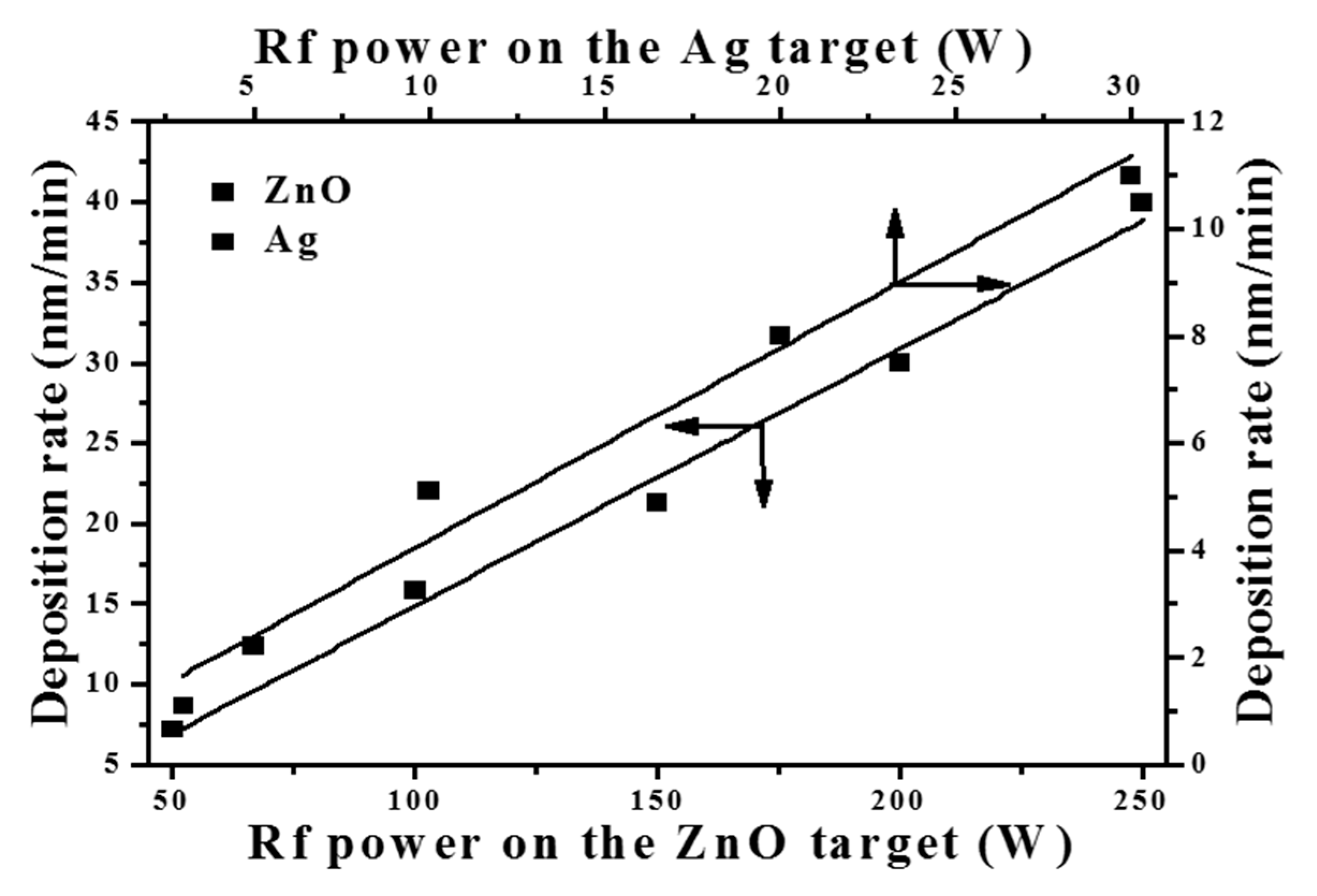


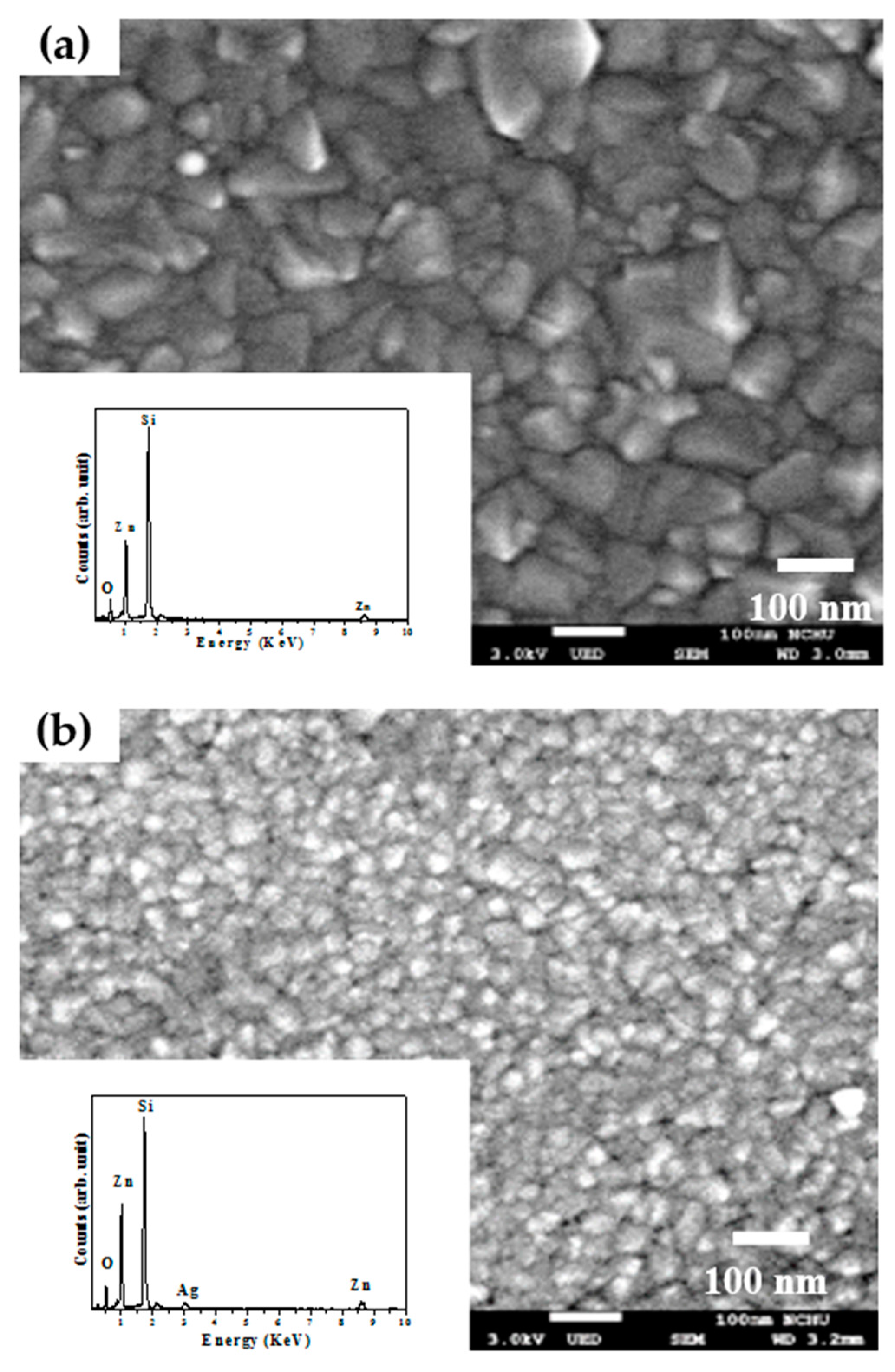
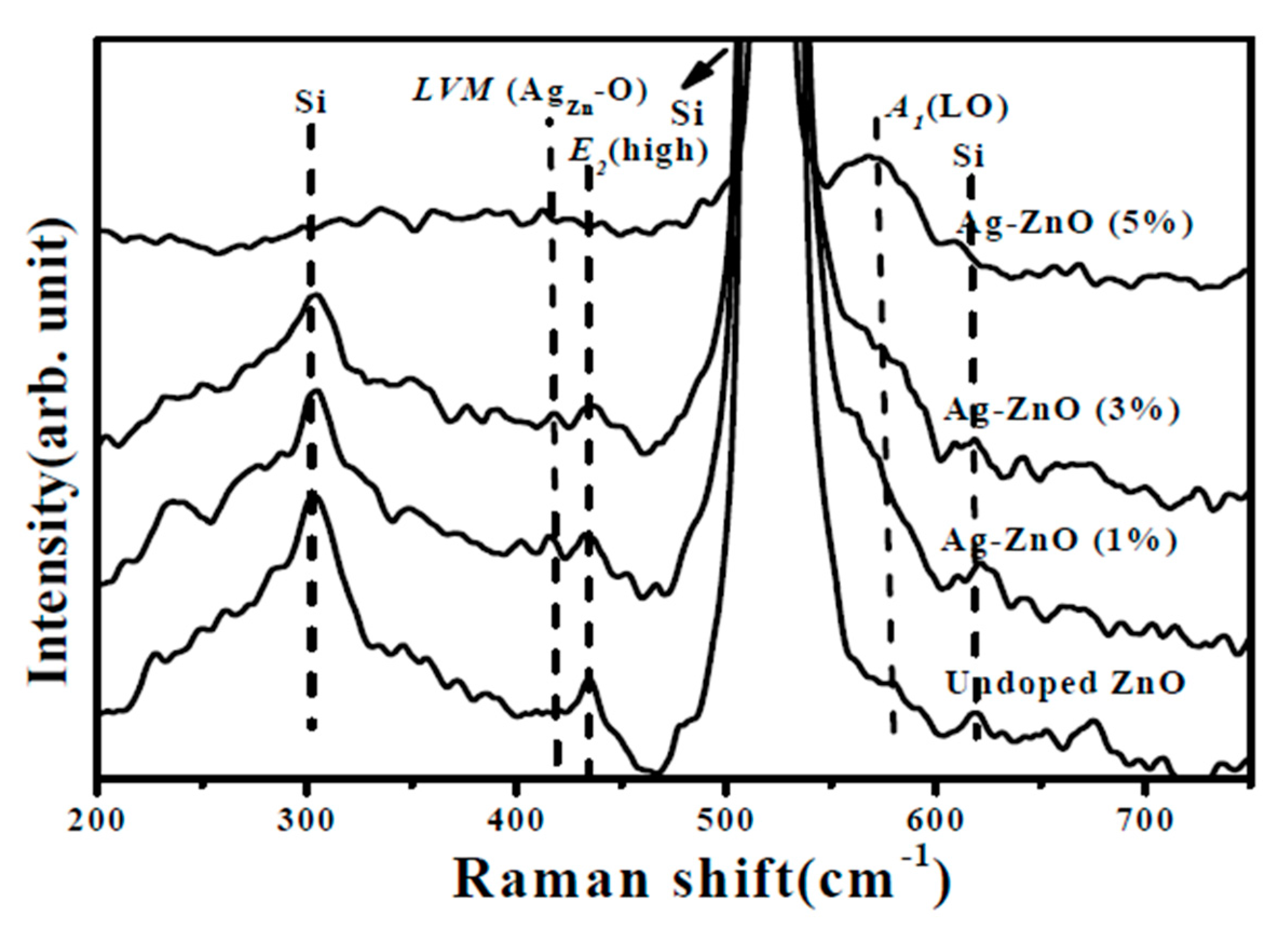
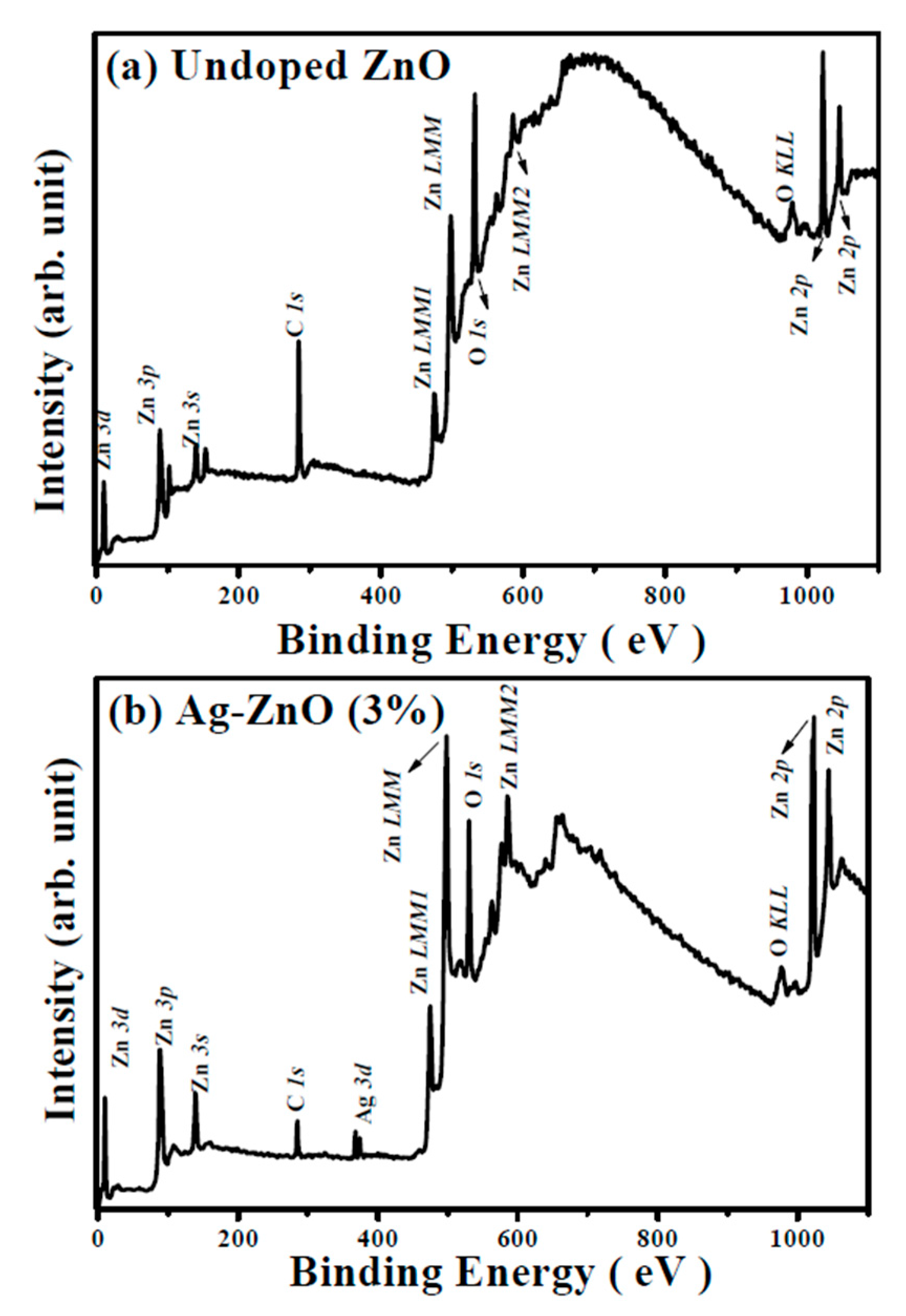
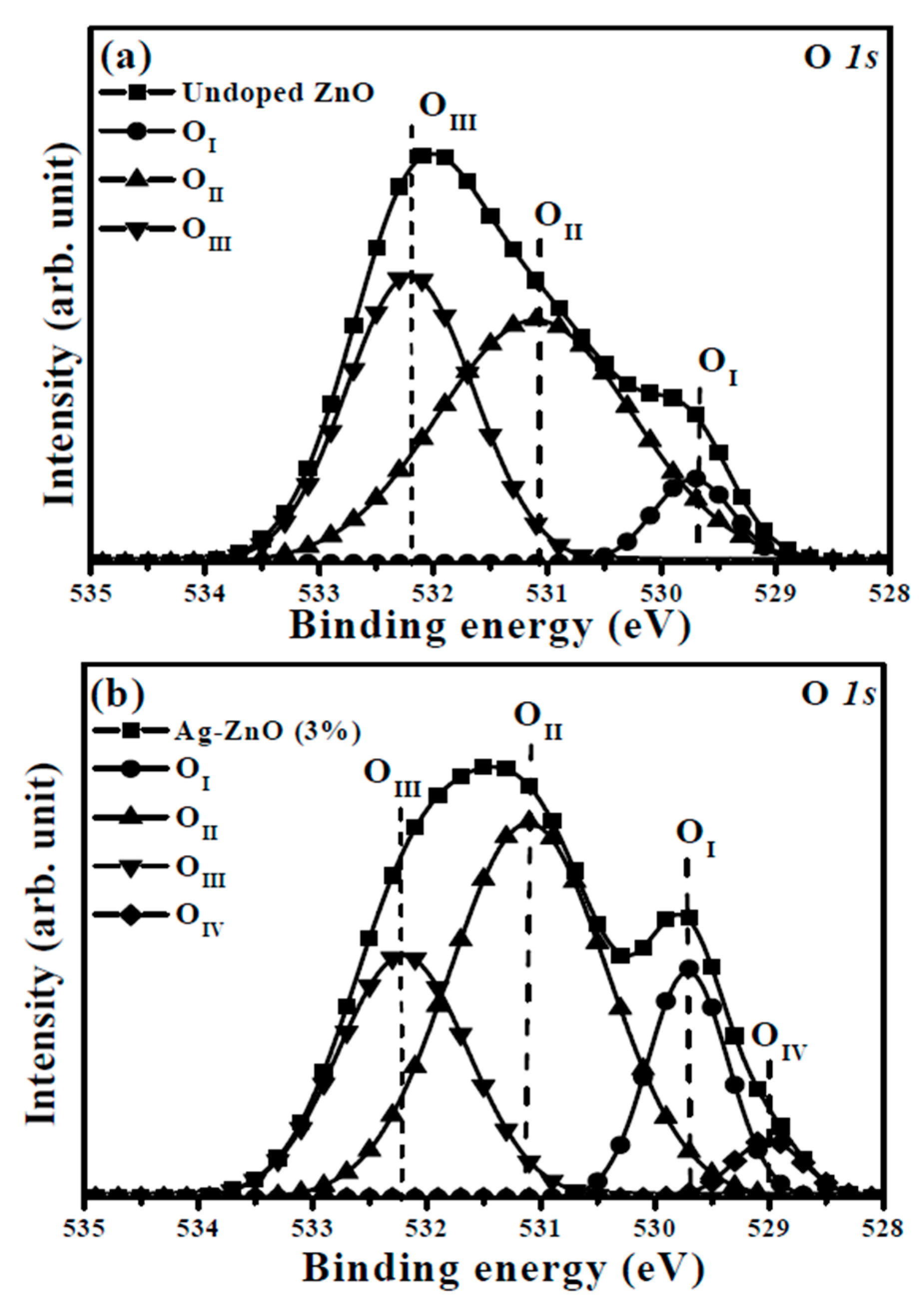
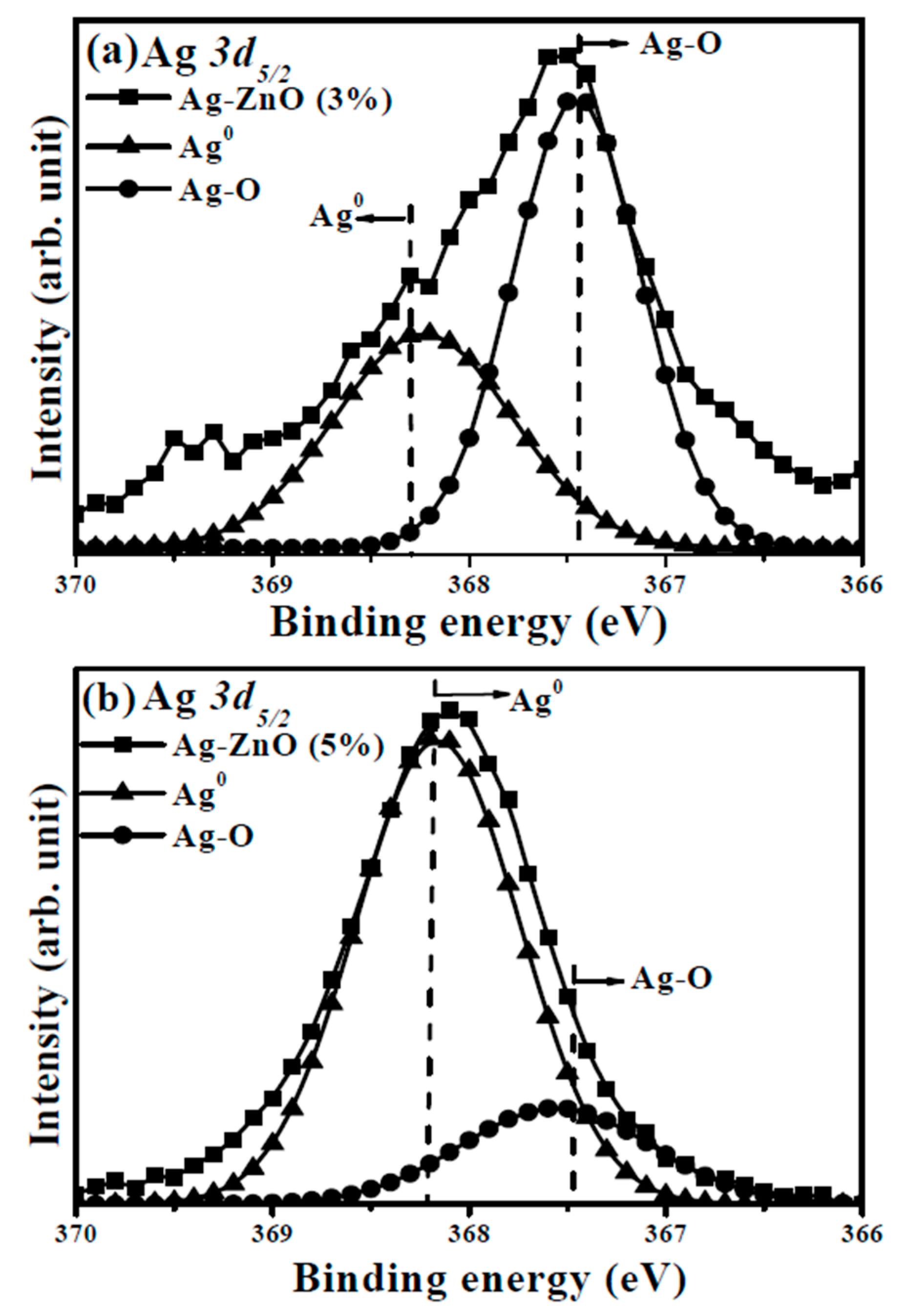
| Sample | n or p (cm−3) | μ (cm2/V s) | ρ (Ω cm) | Tavg (%) |
|---|---|---|---|---|
| Undoped ZnO | N/A | N/A | N/A | 89 |
| Ag-ZnO (1%) | 5.2 × 1016 | 3.3 | 24.1 | 81 |
| Ag-ZnO (3%) | 5.9 × 1017 | 2.9 | 3.5 | 76 |
| Ag-ZnO (5%) | −1.9 × 1020 | 1.9 | 1.8 × 10−2 | 69 |
| Ag-ZnO (8%) | −1.7 × 1021 | 1.5 | 2.4 × 10−3 | 38 |
| Sample | 2θ (deg.) | FWHM (deg.) | D (nm) |
|---|---|---|---|
| Undoped ZnO | 34.48 | 0.43 | 19.1 |
| Ag-ZnO (1%) | 34.34 | 0.48 | 17.2 |
| Ag-ZnO (3%) | 34.32 | 0.50 | 16.6 |
| Ag-ZnO (5%) | 34.56 | 0.56 | 14.9 |
© 2017 by the authors. Licensee MDPI, Basel, Switzerland. This article is an open access article distributed under the terms and conditions of the Creative Commons Attribution (CC BY) license (http://creativecommons.org/licenses/by/4.0/).
Share and Cite
Liu, F.-C.; Li, J.-Y.; Chen, T.-H.; Chang, C.-H.; Lee, C.-T.; Hsiao, W.-H.; Liu, D.-S. Effect of Silver Dopants on the ZnO Thin Films Prepared by a Radio Frequency Magnetron Co-Sputtering System. Materials 2017, 10, 797. https://doi.org/10.3390/ma10070797
Liu F-C, Li J-Y, Chen T-H, Chang C-H, Lee C-T, Hsiao W-H, Liu D-S. Effect of Silver Dopants on the ZnO Thin Films Prepared by a Radio Frequency Magnetron Co-Sputtering System. Materials. 2017; 10(7):797. https://doi.org/10.3390/ma10070797
Chicago/Turabian StyleLiu, Fang-Cheng, Jyun-Yong Li, Tai-Hong Chen, Chun-How Chang, Ching-Ting Lee, Wei-Hua Hsiao, and Day-Shan Liu. 2017. "Effect of Silver Dopants on the ZnO Thin Films Prepared by a Radio Frequency Magnetron Co-Sputtering System" Materials 10, no. 7: 797. https://doi.org/10.3390/ma10070797




